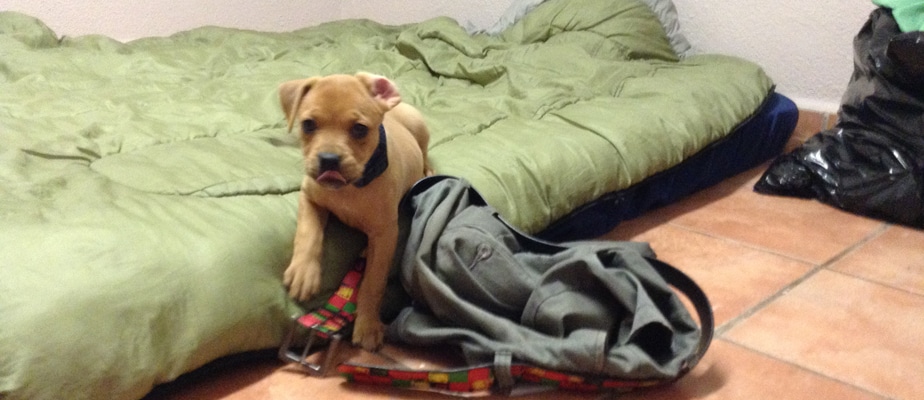Dog Training: Having a dog is a very serious commitment. Of course you can be a bad dog owner and just put your dog in the backyard and just feed him. But if you want to have a well behaved dog and a dog you can take with you places it’s important you start training them right away.
If you get your dog as a puppy then training should start with crate training. If you happen to adopt an older dog then you should start behavior training the day you take them home.
Where they are in their training when you get them home will give you an idea of where to start.
There are several ways to train your dog from treat training to prong collar training. Both work if you know what you are doing. Dogs look to you for guidance. They look to you to let them know what they should do.
If you don’t let them know you are the boss then their behavior will reflect that. Some people think that a dog that just sits there with no excitement is not happy. Quite the contrary. A dog that can sit for a long time is a very happy dog.
A dog that is acting crazy and always running around, barking and sniffing is a dog that is confused and not sure exactly what to do.
Table of Contents
Dog Training: Lesson #1 –Training Requires Consistency
Dog training needs consistency. You have to practice commands every day for at least 30 minutes. I have found working at least 30 minutes every day on one command really gets my dog to understand and learn the command on a dime (not having to say the command more than once).
There are always going to be set backs but you have to be patient and keep it up. If the commands are not working it usually that your timing of the correction/reward is at the wrong time. This will confuse the dog and he will not respond correctly.
You can be giving the right command but the correction can be too early or too late. This will get the dog to not react correctly to the command thus creating frustration on both of your parts.
I have also found that getting upset/mad at your dog because he is not following the command does not help the dog training. He will feel your frustration and not listen. It is best to take a time out to calm down and start over.
It takes time and you have to always come back to training even if he is 100% following your commands. Dog training is a work in progress. Dog aggression training is a completely different animal. This leads into my next lesson learned.
Dog Training: Lesson #2 – Dogs Are Stubborn
I am not sure if this applies to all dogs. But both my dogs are stubborn. At first they only listened when they wanted. I had to learn to be more stubborn. That’s the key: out-stubborn them. They don’t want to sit but then you correct them until they do.
Escalating the correction until they sit. Or don’t reward them until they sit. Either way you have to be prepared that your dog might not see you as the leader right away. Especially if you have let them run free since they were puppies or you adopted at an older age.
That’s alright. Just don’t give in and continue to give the command until they give in. Once again don’t get mad (this is my personal issue). They are going to test you until you show them you are more stubborn then them.
It can take more time then you think. Currently my dog wants to lead the walk. I have to constantly correct him until he heels. After a few stiff corrections he usually falls into place.
Then I praise him for heeling correctly. If there is some sort of distraction my dog throws everything out of the window and does not listen at all.
Always reward them with praise as they are following your commands. And correct them if necessary. It’s a real back and forth battle that you have to win. In the long run you will thank yourself for not giving in. Nothing better than a dog that is well trained.
Dog Training: Lesson #3 – Start When They Are Puppies
Starting when you first get your dog as a puppy is the best way to guarantee a well-trained dog. Purchase a crate and teach your puppy to know that is his home and a safe place. Never send your puppy to the crate as a punishment.
That will teach them to associate their crate with punishment and they will not want to go in the crate on their own. Leaving your puppy with all the space of your house or yard will overwhelm them and teach them to not have boundaries. Boundaries are important and the first thing to teach your puppy.
Not to jump on the couch, tables or go to certain places you do not want them to be. Giving them a crate as their own space lets them know where they can hang out vs. where they want to hang out.
Once the puppy knows that the crate is their home then you can start teaching them commands like sit, down, stay and leave it. Teaching them a command a week or two will allow them to learn the commands at a steady pace and not overwhelm them. Oh yeah! You should be also teaching them to go to the bathroom outside vs. in the house. This in itself is pretty difficult.
But like any training you need to be consistent. You should be able to teach your puppy the most basic commands right away. Be patient and consistent and you will see great results. There are tons of videos on Youtube and you can always go to Cesar Milans website to get information.
Dog Training: Lesson #4 – 2 Dogs Are Not Better Than 1
Trying to train 2 dogs is not easier. Since my dogs are competitive about everything they are constantly looking at the other dog to see where they are in comparison. If one dog is a little ahead in the walk then my other dog will try to keep up.
This makes it difficult for me to control either one. Also when my younger one gets frustrated he tries to bite my older dog. My older dog knows not to fight back but it creates confusion. I have learned to take them out separately and work on training them separately until they are both responding correctly. My older dog is afraid of the correction so she will follow instructions to the tee.
My younger dog seems to like pain so the correction really does not work on him. I am trying new things with him. We will see how that goes.
Separately training your dogs is the way to go. I try to spend minimum 30 minutes per day with each dog to get the proper training in for the day. I am going to spend more time on the younger one since he is more stubborn and does not listen as well as my older dog.
Once I get the training of each dog under control I will start walking them together and hopefully in perfect synchronicity.
Dog Training: Lesson #5 – Feed Them After Training So They Think It’s A Reward
Using their food as a reward works. I have been training them before I feed them and if they are not responding I can bribe them with “want to eat?” This gets them excited and usually get them to focus a little better.
I take them to the park in the morning before I feed them and play chuck it with one as the other just cruises around and barks at things. My older one does not like skateboards so occasionally a skateboard comes by and I get to train her to not freak out.
When she freaks out it makes my other one get excited and usually ends in a fight which I do not like at all. It’s only been 2 weeks and there is definite improvement. I let them run free in Mexico since they were puppies so training them is not going to happen overnight.
I have to keep telling myself that so I don’t get frustrated.
Waiting to feed them until after their training session has hand its benefits. They know food is coming and will usually respond better than their day training. I am trying to make it fun for us so I don’t give in because the younger one is so stubborn.
If things don’t change s incorporating treats to get the correction helps if dogs are very food motivated.


